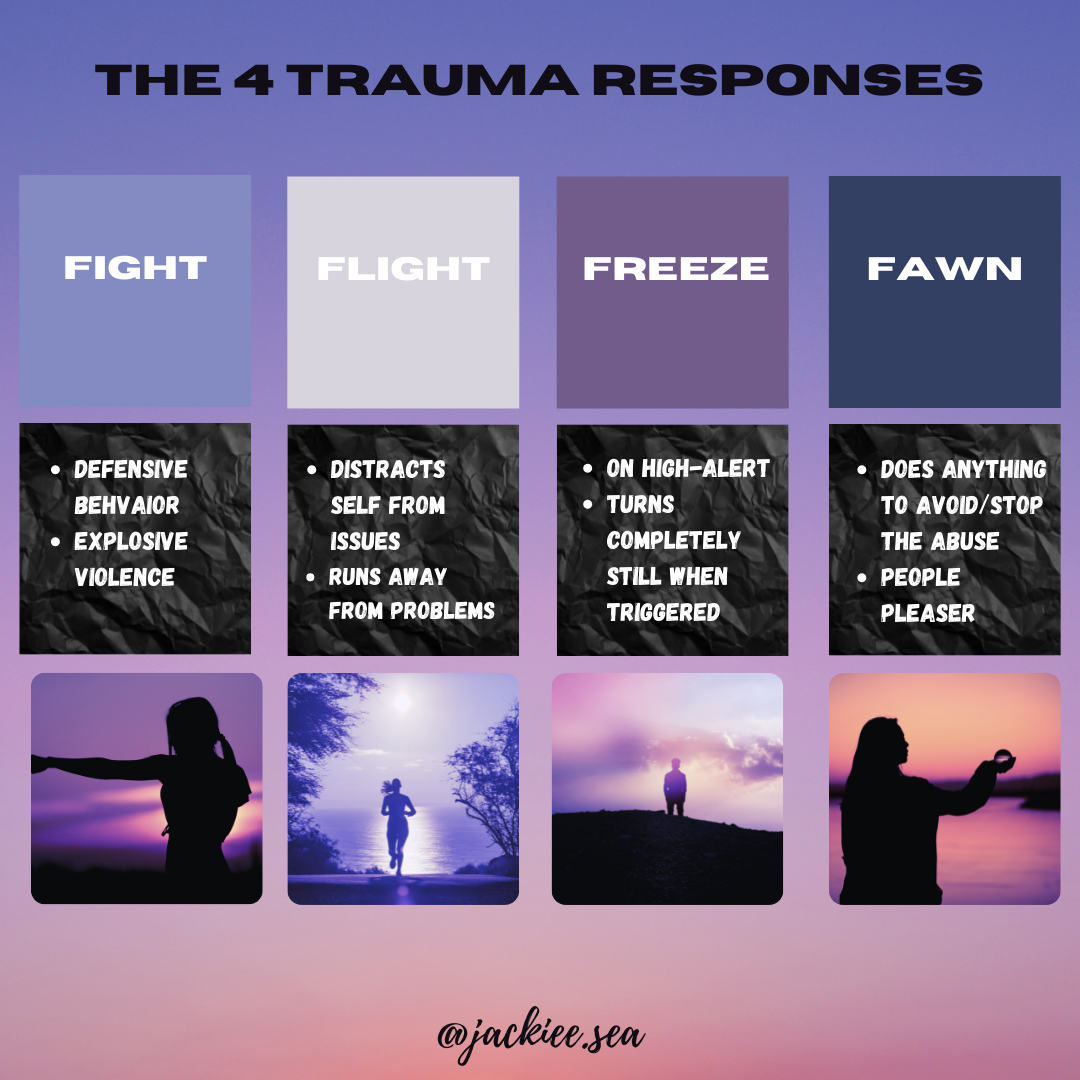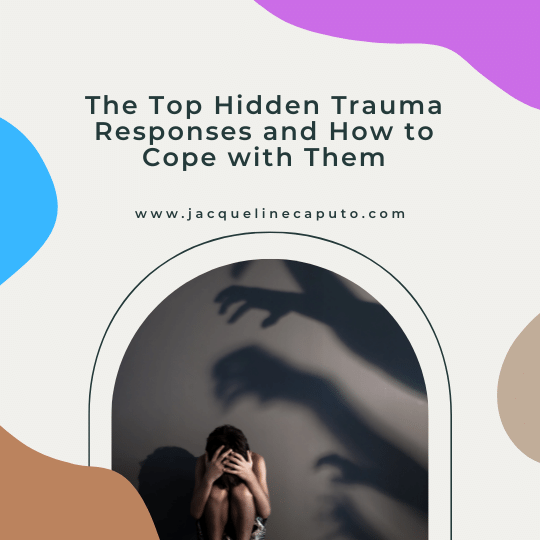When someone experiences trauma in their life, it affects the way they respond to dangerous situations. There are various types of trauma responses: Fight, Flight, Freeze, and Fawn. Each response causes the triggered person to react differently to the imposed threat. Let’s explore these trauma responses.
Before we go any further, let’s point out some terms.
Trauma – When someone experiences trauma, they’ve had a scarring experience (i.e. abuse, war, violence) that has unfortunately impacted their life in a negative way. Trauma causes intense feelings of fear, distress, etc.
Trauma Trigger – something that causes a person to flash back to/relive a distressing event.
Post Traumatic Stress Disorder (PTSD) – PTSD is the mental disorder associated with trauma. When someone has PTSD, they struggle with the aftermath caused by the scarring experience they had. In the words of Bragesjö et al., people with PTSD struggle with “re-experiencing the event, avoidance, cognitive and mood changes, and hyperarousal.”
Complex Post-Traumatic Stress Disorder (CPTSD) – According to Giourou et al., CPTSD is a disorder caused by trauma that is recurring/happening over an elongated amount of time. This usually takes place in early childhood. CPTSD sounds similar to PTSD, but they are not the same. PTSD involves trauma that is caused over a long period of time while PTSD is usually ignited by a singular, scarring event.
Now that these terms are covered, let’s get into common trauma responses.
Flight of Fight:
In times of distress, someone can react in a flight or fight way. When a person is in flight mode, they will see a dangerous circumstance and try their best to escape the threat. The flight response causes the intimidated person to run away or distance themselves from the situation. In fight mode, the person does not run away from the issue – they actually run towards the danger in defense.
Think of it this way – a man is walking home from a late-night dinner with his friends. He starts to notice that another man is walking close behind him as he travels. Since he has been mugged before and experienced trauma from this event, the man assumes the late-night traveler is going to do the same.
In flight mode, this man would start walking faster or even start running to rid themself of this follower. He might flee to an open store and try to find refuge there. If the man ended up in fight mode, he could have explosively reacted to his stalker. He might have yelled, screamed, or used violence to fend the person off.
Freeze:
When someone experiences this response, they are stopped dead in their tracts. When a threat presents itself, this person will freeze in place – this experience usually only lasts for a few seconds. Explained by Kozlowska et al., this type of reaction makes the triggered person hypervigilant. The person is on high alert, waiting/preparing for anyone to attack.
Imagine a woman that grew up being emotionally abused by her parents. When she gets older, she enters a romantic relationship. One day, she and her partner start disagreeing on a topic, and it gets heated. Her partner raises their voice at the woman, and she just freezes. Her partner looks in confusion and worries as the woman stands completely tense and still. After moments of silence, the woman finally snaps out of this state.
Fawn:
Fawning is a trauma response that involves appeasing others to alleviate the risk of arguing, fighting, or abuse. Peter Walker is the person who first coined the term “fawn response” and developed what is now called CPTSD. Walker suggests that codependent people are most affected by fawning. As discussed in the Psychology Today article by Sherry Gaba LCSW, people who fawn were usually abused as children – when they were young they tried to thwart their abuser by any means possible. Fawning can affect people as they grow older to become dedicated people-pleasers with an inability to set boundaries with others.
Think of it this way – a man was abused by his father growing up. He would always try his best to make his dad happy and distract him from inflicting harm. As he got older, the man focused more on the needs of others than his own. He struggles setting boundaries with and saying no to people, especially his toxic, manipulative “best friend.”

How to Cope when you Experience a Trauma Response:
First, Focus on Your Breathing.
Breathing is the simplest and most innate task a person can accomplish. Although simple, it can greatly impact us. In times of major stress, use simple breathing techniques to calm down your system and bring inner peace. The peace that these breathing methods provide would be helpful for calming someone down in fight mode.
Second, Write Down and Identify Your Triggers.
When you feel triggered by a person, place, or situation – note it down. Write on a piece of paper or even the Notes App on your phone. You can journal to explore this event and what exactly took place. Journaling allows you to write out your thoughts and examine them.
By taking notes of these provoking events, you can start identifying your major triggers and taking steps to avoid/work through these stressors.
Third, Practice Positive Affirmations and Positive Self-Talk.
When you feel triggered and horrified from your trauma, show compassion for yourself through your thoughts. Challenge your negative beliefs by repeating positive affirmations. These affirmations act as words of encouragement in the times we need them most. These can be especially useful in encouraging people who fight or freeze in response to danger – these uplifting words can assure the people that things will all be ok. Some affirmations to use are:
I can get through this moment – I always have.
I am strong.
I am capable of healing and growth.
I deserve happiness and inner peace.
Fourth, Embrace Support.
Trauma chronically impacts people. Many times, these events have devastating and challenging effects on our lives. Remember that you don’t have to go through any of this alone – It is ok to ask for help! Turn to trusted loved ones or friends that you can vent to, take advice from, or just exchange a warm embrace with.
If you feel like things are getting worse, consider professional help. A therapist using, for example, Cognitive Behavior Therapy (CBT), can help you deal with your trauma and find ways to cope. For example, if someone was abused growing up and started fawning, they are probably huge people-pleasers. A therapist can help this person break away from their people-pleasing ways and set healthy boundaries with others.
Eye Movement Desensitization and Reprocessing (EMDR) can also help people who experience trauma. This type of treatment is well-known for treating people who have PTSD. EMDR allows patients to heal from past trauma by tapping into the benefits of Rapid Eye Movement (REM) during sleep. Many researchers, like Mcguire et al., regard this model as the most effective, better tolerated by clients, and more convenient (requiring fewer sessions).

About the Author
Jackie Caputo is a Licensed Marriage and Family Therapist who provides therapy in Woodland Hills, CA. She also provides online therapy in California to individuals throughout the state.

